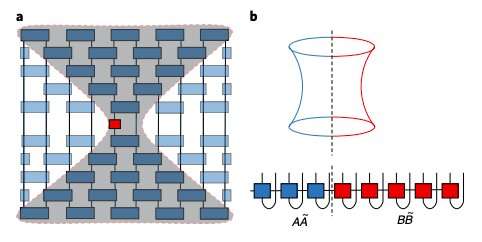Sketch of the emergent light cone and entanglement structure of local Heisenberg operators in tensor network forms. Credit: Xu & Swingle.
In quantum physics, scrambling is the dispersal of quantum information across a complex quantum system, such as chaotic quantum many-body systems. This process can make quantum information difficult or impossible to access, particularly when using simple and conventional physics methods.
Scrambling can be measured using out-of-time-ordered correlators (OTOCs), which are measures of quantum chaos tied to the growth of Heisenberg operators. Researchers at the University of Maryland have recently introduced a new method to calculate OTOCs of local operators in 1-D systems. This method, presented in a paper published in Nature Physics, could ultimately be used to study scrambling in complex quantum systems.
"The basic issue that we were trying to understand is how chaos spreads in space in quantum systems," Brian Swingle, one of the researchers who carried out the study, told Phys.org. "Think of the butterfly effect thought experiment—we wanted to know: if a butterfly flaps its wings, how fast does that perturbation spread in space? We wanted to understand this specifically in the context of quantum systems composed of many particles."
Previous studies investigating how chaos spreads in space within quantum systems gathered several interesting observations, painting an interesting but rather complex landscape of possible behaviors. Many of these studies, however, were based on special assumptions and this makes it harder to determine to what extent their conclusions can be generalized to other systems.
In their study, Swingle and his colleague Shenglong Xu set out to investigate which behaviors unveiled in previous studies are generic to all quantum systems. They also hoped to understand how one can think about the landscape of possibilities occurring in different special systems.
"To get a handle on what the generic behavior was, we needed a method to calculate OTOCs in generic systems," Swingle said. "Such a method would need to utilize some generic property of OTOCs in local systems."
The researchers' idea was to use the lightcone property of quantum systems, which entails that outside of the expanding cone of influence arising from the metaphorical butterfly's wing flap, the system is hardly perturbed. In other words, outside of the 'butterfly cone' the effect of the butterfly remains small.
In quantum mechanics, actions are represented as operators and the smallness of a given effect translates into the simplicity of the operator. Leveraging this simplicity, Swingle and Xu were able to represent the operator in a computationally useful way (i.e., as a 'matrix product operator'), in order to carry out the calculations necessary to access scrambling.
"There are two key achievements in our study," Swingle said. "First, we devised a theoretical framework to classify various possible behaviors of the OTOC. This framework was general enough to include all the previously known examples. Second, we formulated a general purpose method to compute OTOCs, a method which could go beyond previous calculations."
Swingle and Xu have already used their method for calculating OTOCs of local operators to study a variety of generic systems. Interestingly, they found that several of these systems fit into their theoretical framework. In a follow-up study featured in Physical Review X, the researchers also used their method to gather evidence that OTOCs in generic chaotic systems have a universal behavior.
"We have followed up this work by applying our technology to several different systems being studied in table-top experiments around the world," Swingle said. "We are now also generalizing the approach to include new kinds of effects, including studying systems at low temperature where the speed of chaos spreading tends to slow down."
More information: Shenglong Xu et al. Accessing scrambling using matrix product operators, Nature Physics (2019). DOI: 10.1038/s41567-019-0712-4
Shenglong Xu et al. Locality, Quantum Fluctuations, and Scrambling, Physical Review X (2019). DOI: 10.1103/PhysRevX.9.031048
Journal information: Physical Review X , Nature Physics
© 2019 Science X Network
























